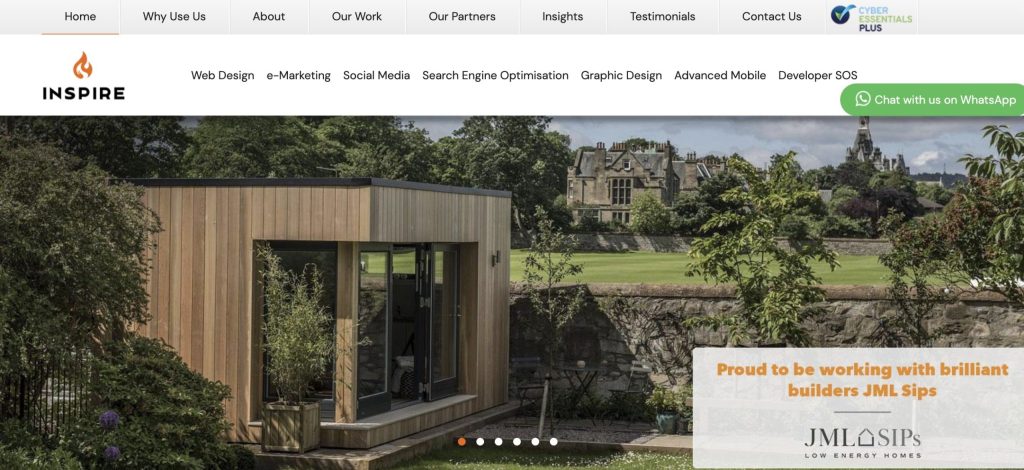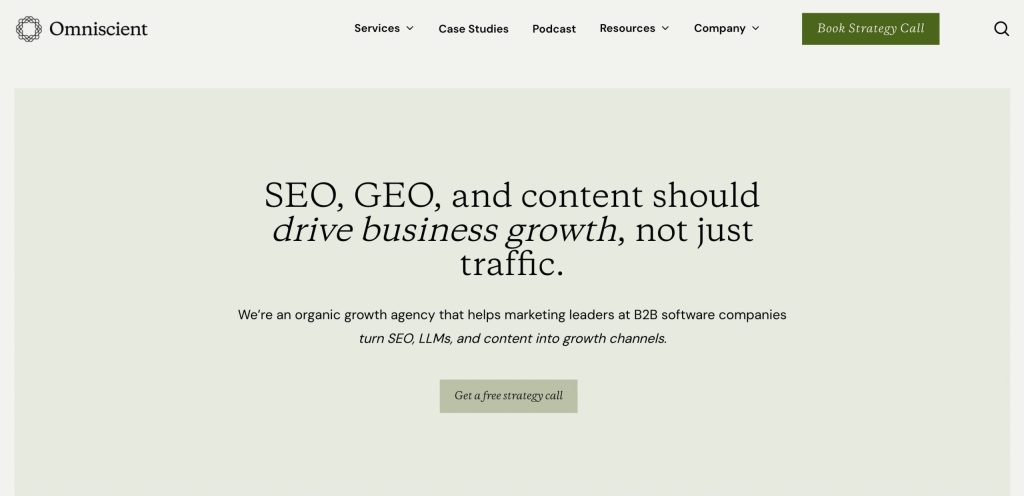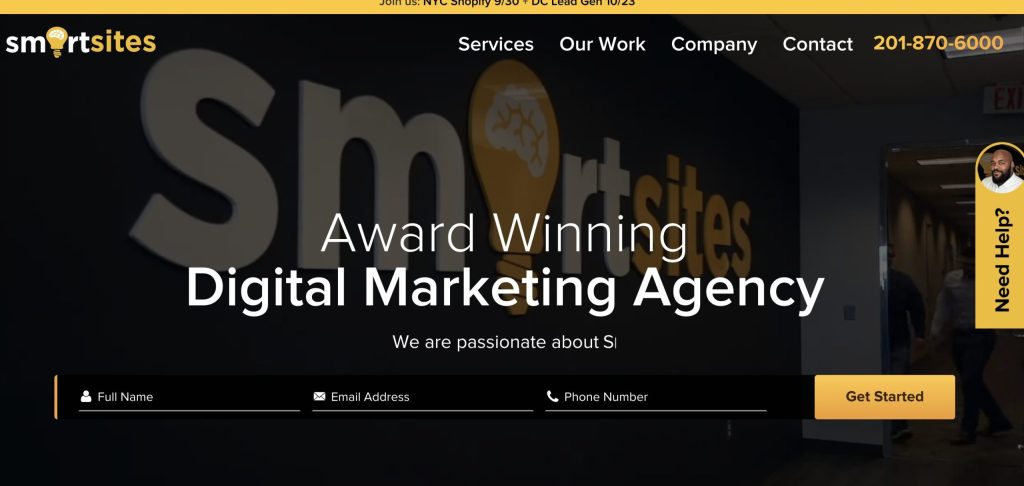You don’t need “AI sprinkles.” You need outcomes: pipeline, qualified demos, revenue. This listicle cuts through the noise and spotlights AI SEO programs that actually move ARR in SaaS, Ecom, and B2B.
AI is rewriting search and buyer behavior. Generative results and LLM answers reward entities, authority, and corroboration not just keywords.
Below, you’ll see exactly how we selected the top agencies, what to expect, and how to vet them with a checklist.
In this article…
- How We Chose the Best AI SEO Agencies
- 1. BlueTree Digital – Editor’s Pick for SaaS/B2B Authority Building
- How Does Generative Engine Optimization (GEO) Work?
- What is AI SEO?
- Do You Really Need GEO in 2025?
- Why Link Earning Still Wins in AI Search
- How To Choose an AI SEO Agency
- Conclusion
- FAQ – Best AI SEO Agencies
Key Takeaways
- Editorial link earning beats shortcuts. It compounds authority, feeds clusters, and increases the odds of AI citations.
- Entities and schema come first. Structure pages so machines instantly understand relationships and reuse your answers.
- Measure beyond rankings. Track LLM citations and assisted pipeline next to classic SEO KPIs.
- Vendor selection is a process check. Demand proof of GEO, editorial links, QA, and revenue reporting.
- BlueTree is the authority play. When you need white-hat link earning plus entity-first content for SaaS/Ecom/B2B, it’s the durable choice.
How We Chose the Best AI SEO Agencies
We scored agencies on AI + GEO capability, SaaS/Ecom/B2B fit, execution velocity, proof, stack transparency, pricing clarity, and strategist seniority.
The kicker? We weighted what correlates with revenue, not vanity metrics. Keep reading for the full scorecard and red flags to avoid.

Great rankings don’t guarantee revenue; alignment with how modern buyers research does. Our method focuses on how agencies influence LLM answers and AI-powered SERPs while fortifying classic organic acquisition.
Translation: fewer “pretty dashboards,” more qualified sessions, trial starts, and SQLs.
We also modeled fit by company stage (Seed to Enterprise), because the same “AI SEO” playbook shouldn’t be used for a PLG SaaS, a headless Ecom brand, and a B2B services firm.
Our Selection Scorecard
| Criterion | Weight | What We Looked For | Why It Matters |
| AI + GEO Capability | 30% | Entity-first content, schema depth, answer-engine optimization, LLM citation lift | Drives visibility in AI Overviews & chat answers |
| Industry Fit (SaaS/Ecom/B2B) | 20% | ICP-aware keyword strategy, sales cycle mapping, category creation support | Converts visitors into pipeline, not just traffic |
| Execution Engine | 15% | Editorial ops velocity, technical rigor, white-hat link earning | Speeds time-to-value and sustains growth |
| Proof & Measurement | 15% | Case metrics tied to revenue/activation, LLM visibility tracking | Cuts fluff; proves real impact |
| Tooling & Stack | 10% | Transparent AI + SEO tools, automation with QA, reproducible process | Reduces risk and dependency on “heroics” |
| Pricing Clarity | 5% | Tiered retainers, scope transparency, path to scale | Prevents surprise invoices and misalignment |
| Team Seniority | 5% | Strategists with domain depth (PLG, Ecom taxonomy, complex B2B) |
Red Flags & Deal-Breakers
Too many “AI SEO” offers are just content autopilot. If drafts ship straight from a model to your CMS without human QA, you’re gambling with brand trust and topical accuracy.
AI accelerates research and drafting, but unreviewed outputs create hallucinations, style drift, and thin expertise signals.
That’s a liability in competitive SaaS, Ecom, and B2B categories where evaluators scan for proof, not fluff. Demand a workflow where human editors fact-check, tighten claims, and align voice.
Another quiet killer is the absence of a schema plan. If an agency can’t show how they’ll structure product, organization, author, FAQ, and how-to schema, and how those tie back to your entity model you won’t be machine-understandable.

Crawlers and models both rely on structured context to map relationships. Schema depth, internal linking rules, and content design patterns should be documented up front, not bolted on after launch.
Link promises expose strategy quality in seconds. If the pitch leans on paid placements or “guest posting packages,” your risk climbs while authority stagnates.
Editorial links from relevant publications are earned, not purchased. Ask for their plays: data assets, source commentary, partner content, and PR hooks that attract citations.

Topic factories are another red flag. If briefs don’t ladder to ICP pain points, use cases, and revenue stages, you’ll get traffic that doesn’t convert.
Strategy must map features to problems, alternatives pages to competitive intent, and help-center content to activation moments.
For SaaS especially, aligning docs, integrations, and onboarding content with search is where trials and expansion revenue hide.
The same logic applies to Ecom: taxonomy, filters, and programmatic pages need to reflect real shopper behavior.
Finally, opacity around pricing signals operational chaos. You should know exactly what’s delivered weekly, how quality is assured, and how success is measured.
Clarity on retainers, scope, and staffing prevents misalignment and it’s a tell for maturity. If reporting stops at rankings instead of trials, pipeline, and assisted revenue, you’re paying for theater. Ask for the measurement plan before kickoff.
1. BlueTree Digital – Editor’s Pick for SaaS/B2B Authority Building
BlueTree is the authority-building engine you hire when you want defensible rankings and durable mentions in AI-influenced results.

They pair AI-assisted research with white-hat link earning and entity-first content systems. The outcome: higher intent traffic, stronger category coverage, and compounding domain trust.
What does BlueTree actually deliver?
Editorial links, authority-stacked content, and technical hygiene prioritized by revenue potential. The punchline: fewer random posts, more pages that win demos and trials. Now let’s unpack the components and how they fit your go-to-market.
BlueTree centers programs on white-hat link earning, not link buying. That matters because editorial mentions improve rankings for competitive SaaS and B2B queries where E-E-A-T and corroboration are visible differentiators.
Their content function leans entity-first: product pillars, use-case clusters, alternatives/competitors, integrations, and help-center expansions. Each is designed to support commercial intent, internal linking, and structured data.
Technical work focuses on crawlability, schema depth, and internal architecture so clusters pass equity and make sense to both crawlers and LLMs.
The result is an authority system that compounds.
Numbered process (snapshot):
- Opportunity model → entity map → cluster plan
- SME interviews → AI-assisted briefs → human-edited drafts
- Schema + internal link architecture by template
- Editorial link earning (digital PR, partners, sources)
- Outcome reporting tied to trials, SQLs, revenue
For SaaS, BlueTree prioritizes “features → problems → outcomes” pages, alternatives comparisons, integrations, and help-center SEO linked to activation. The measurement lens is trials, PQLs/MQLs, and SQL rate.
For Ecom, the focus is on taxonomy cleanup, filters, and programmatic SEO for long-tail discovery, backed by brand storytelling and user-generated proof.
For B2B services, they pair executive POV content with proof assets (case studies, ROI narratives) to move complex deals. In all three, link earning is the growth multiplier and editorial mentions make clusters stick and widen coverage.
Table: Same Backbone, Different Emphasis
| Motion | Content Priorities | Technical Focus | Link Earning Angle | KPI Focus |
| SaaS | Use cases, alternatives, integrations, docs | Schema, docs discoverability | Source commentary, integration partners | Trials, PQL→SQL, expansion |
| Ecom | Collection pages, filters, programmatic | Facets, speed, structured data | Product PR, community features | AOV, CVR, incremental sessions |
| B2B | Thought leadership, case content, POV | Knowledge hub architecture | Industry publications, analyst mentions | SQLs, win rate, sales cycle |
2. Inspire Digital
If your mandate is “show up in AI answers,” Inspire Digital leans hard into Generative Engine Optimization (GEO): entity-first content, corroboration, and mention-level optimization to get cited in LLMs and AI Overviews.

Expect senior strategy, crisp playbooks, and tight editorial quality controls.
Core offer: GEO strategy + execution, entity mapping, schema depth, editorial content built to earn citations.
Pricing on site: Not publicly listed (custom/quote-based).
3. Intero Digital
Intero’s strength is full-funnel SEO that scales technical, content, and digital PR wrapped in enterprise reporting and governance.

The pitch: integrated programs that connect search to revenue and brand outcomes across complex sites and teams.
Core offer: Enterprise-grade technical SEO, content engines, digital PR, analytics alignment, and internationalization.
Pricing on site: Not publicly listed (custom/quote-based).
4. Flow Agency (formerly Flow SEO)
Flow is a boutique team built for SaaS and professional services. They push entity maps, bottom-of-funnel content (use cases, alternatives, integrations), and pragmatic link earning.

Their ops are lean, and you work with senior strategists not a junior pod.
Core offer: B2B/SaaS SEO strategy, cluster planning, programmatic & technical SEO, and editorial link earning.
Pricing on site: Minimum monthly retainer publicly listed at $3,500/mo.
5. Omniscient Digital
If you need a content engine tied to pipeline, Omniscient builds “surround-sound” authority: research-driven strategy, full-funnel content, and steady technical support.

Known for rigorous briefs, SME depth, and measurement that goes beyond rankings.
Core offer: Strategy, research, production, optimization, and reporting mapped to trials, demos, and revenue.
Pricing on site: Full-service engagements start at $10,000/mo; standalone SEO/content strategy starts at $15,000.
6. NoGood
NoGood is a growth agency that integrates SEO with experimentation, CRO, and content ops. The value prop: AI-assisted research and production, backed by robust QA and analytics to push learning velocity without sacrificing brand safety.

Core offer: SEO integrated with growth experimentation, programmatic content, and advanced measurement.
Pricing on site: Not publicly listed (custom/quote-based).
7. SmartSites
Smartsites is a large, process-driven team with deep Ecom and SMB experience.

Expect standardized onboarding, clear scopes, and AI-assisted workflows for briefs and on-page optimization – useful when you need dependable volume and cadence.
Core offer: Full-service SEO (technical, on-page, content support) with strong Ecom and local SEO execution.
Pricing on site: Not publicly listed (custom/quote-based).
Comparison Grid
| Agency | Best Fit | Core Strength | AI/GEO Emphasis | Pricing Visibility |
| Spicy Margarita | B2B teams prioritizing AI answer visibility | GEO, entity strategy, editorial content | Very high (LLM citations & AI Overviews) | Custom (not listed) |
| Intero Digital | Mid-market to Enterprise with complex sites | Enterprise technical + content + PR | High (entity-driven content & schema) | Custom (not listed) |
| Flow Agency | B2B/SaaS needing senior-led, focused SEO | Entity maps, BOFU content, programmatic SEO | High (LLM-aware content, schema) | Minimum listed ($3,500/mo) |
| Omniscient Digital | B2B SaaS needing content engine tied to pipeline | Strategy + production + measurement rigor | High (authority clusters, AEO/GEO-aware) | Starting rates listed ($10k+/mo; $15k strategy) |
| NoGood | Growth-minded orgs seeking SEO + experimentation | AI-assisted ops, CRO integration | Medium–High (programmatic & analytics) | Custom (not listed) |
| SmartSites | Ecom/SMB needing standardized delivery at scale | Process-driven on-page/tech, Ecom/local | Medium (AI-assisted workflows) | Custom (not listed) |
Pricing Snapshot
Most AI SEO shops price by scope, not hours. When numbers are public, they usually represent minimums.
Use this grid to gauge budget bands, then pressure-test value against pipeline impact and editorial link earning.
| Agency | Public Pricing (as listed) | Typical Engagement | Notes |
| Spicy Margarita | Not listed (custom) | Strategy + execution | GEO-first programs aimed at LLM/AI answer visibility |
| Intero Digital | Not listed (custom) | Enterprise SEO + PR | Scales across complex sites, governance-heavy |
| Flow Agency | From $3,500/mo | Retainer | Senior-led SaaS/B2B SEO, entity mapping, programmatic |
| Omniscient Digital | From $10,000/mo (full-service) / $15,000 (strategy) | Retainer / project | Content-led growth for B2B SaaS tied to pipeline |
| NoGood | Not listed (custom) | Retainer | SEO integrated with experimentation/CRO |
| SmartSites | Not listed (custom) | Retainer / packages | Ecom/SMB-focused, standardized delivery |
Pricing changes. Treat these as public minimums, not guarantees. Always validate current rates during discovery.
How Does Generative Engine Optimization (GEO) Work?
GEO earns your brand a seat inside AI answers by structuring entities, evidence, and citations so LLMs can trust and quote you.
The move most teams miss: build corroboration across the web, not just content on your site.
GEO treats every page as a data source for models, not just a document for crawlers. You start by defining an entity map of your product, use cases, competitors, and categories.
Then you structure content (on-page copy, tables, FAQs, how-tos) with schema so machines can parse relationships.
Next, you corroborate claims with third-party evidence – original data, expert commentary, and assets that attract editorial links.
Internally, you weave a tight linking pattern so clusters are explicit: pillars → use cases → integrations → comparisons.
Finally, you measure visibility beyond rankings: LLM citations, AI Overview presence, and mention share in topically relevant queries.
Core mechanics to execute GEO well
- Entities first: Define product features, problems solved, ICPs, competitors, integrations.
- Structure everything: Product/FAQ/How-To/Organization/Author schema; consistent component patterns.
- Evidence engine: Data studies, field research, case results – built to earn editorial mentions.
- Corroboration flywheel: Publish → pitch → earn citations → update pages with new proof.
- Cluster governance: Naming conventions, URL patterns, UX modules that repeat (and scale).
- Reporting beyond rankings: Track LLM citations, AI Overview placements, and assisted pipeline.
Mini-framework (five steps)
- Map entities (product, problems, categories, alternatives).
- Design clusters (pillars, use cases, integrations, comparisons).
- Standardize schema + internal link templates across layouts.
- Earn editorial links with PR-worthy assets and subject-matter commentary.
- Measure AI visibility alongside trials/SQLs; iterate by coverage gaps.
What is AI SEO?
AI SEO blends classic search fundamentals with entity modeling, structured data, and editorial corroboration so algorithms and LLMs can trust and reuse your content.
The surprise? It’s less about “more pages” and more about clearer signals. Here’s how to build them fast.
AI SEO treats your site like a knowledge graph, not a scrapbook. You map the core entities: product, use cases, industries, integrations, alternatives and then structure pages so machines can understand relationships at a glance.
That means reusable components (comparison tables, FAQs, step-by-steps), clean schema (Product, FAQ, HowTo, Organization, Author), and internal linking rules that pass equity through clusters.
The content itself is expert-led and AI-assisted: ideation and first drafts move faster, while humans tighten claims, examples, and tone.
Finally, you earn editorial links to corroborate what you say. In the AI era, corroboration is the currency that makes models comfortable citing you.
When you combine entity-first content, schema depth, and white-hat link earning, you get compounding authority, fewer pages do more work, and new pages rank faster.
AI SEO vs. Traditional SEO (quick contrast)
| Area | Traditional Focus | AI SEO Focus |
| Research | Keywords & volume | Entities, relationships, intent depth |
| Content | Long-form pages | Modular, structured, machine-readable |
| Links | “Get more links” | Earn editorial citations from relevant sources |
| Tech | Crawl/index basics | Schema depth, component patterns, templates |
| Measurement | Rankings & traffic | Rankings + LLM citations + AI Overview presence + pipeline |
Do You Really Need GEO in 2025?
If your buyers see AI answers before traditional SERPs, you need GEO. If your growth relies on demos, trials, or high-consideration purchases, you definitely need GEO.
The trick is sequencing it so it accelerates the pipeline.
Generative Engine Optimization (GEO) isn’t a separate channel; it’s the layer that gets your expertise pulled into AI answers.
For SaaS, prospects often compare alternatives, check integration fit, and skim docs because GEO helps your product’s language, evidence, and structure align with how models “think.”
For Ecom, GEO speeds discovery for long-tail, attribute-rich queries when shoppers ask conversational questions.
In B2B, where committees want de-risked decisions, mention-level optimization and editorial corroboration get your brand referenced as “the safe choice.”
The decision point is simple: if your analytics show branded discovery plus high non-brand research, and your buyers use AI assistants (internal or external) during evaluation, GEO is a multiplier.
Start with entity mapping, retrofit schema and components into key pages, and spin up an editorial link pipeline.
Keep measurement honest: track LLM citations, AI Overview presence, and assisted pipeline next to rankings.
Signals you’re ready for GEO
- You have (or can create) proof assets: case studies, data stories, ROI snapshots
- Your product/offer has clear entities: features, use cases, integrations, categories
- You can maintain quality at speed: AI-assisted drafts + human SME review
- You’re already investing in white-hat authority building, not buying placements
Why Link Earning Still Wins in AI Search
Editorial links are trust signals models and algorithms reuse. Bought links inflate counts, not credibility.
If you want durable rankings and AI citations, earn mentions from relevant publications – and structure pages so those signals compound.
Search engines and LLMs privilege corroborated expertise. When reputable sites cite your research, data, or commentary, your entity gains authority in the topic graph.

That authority spreads across clusters (pillars → use cases → comparisons), helping new pages index, rank, and appear in AI-style summaries faster.
Paid placements can spike counts, but they rarely move this graph and they add risk.
The better path is an editorial pipeline built on assets that others actually want to reference: original data, teardown analyses, field studies, and partner stories.
Pair that with consistent schema and internal links so your most link-worthy pages pass equity to commercial pages.
Link strategy comparison
| Approach | What You Get | Risk Level | Impact on AI/LLM Citations |
| Editorial link earning | Mentions in relevant publications | Low | High – corroborates entities and claims |
| Paid placements | Manufactured links on low-relevance sites | Medium–High | Low – weak evidence signal |
| Directory spamming | Volume in thin sites | Medium | Very low – often ignored or discounted |
How To Choose an AI SEO Agency
Demand proof of GEO capability, entity-first content, editorial link earning, and reporting tied to pipeline – not just rankings.
Press for process depth, QA standards, and pricing clarity. If they can’t show evidence and governance, keep walking.

Your selection call is a stress test. Start with how they’ll map your entities (product, use cases, integrations, alternatives) and translate that into clusters and schema.
Ask to see a real editorial link pipeline, not “guest post packages.” Check for AI-assisted workflows with human QA: SME interviews, fact-checking, legal review, and brand voice gates.
Pricing should outline weekly deliverables and quality checks not vague “hours.” Finally, reporting must connect to pipeline: trials, demos, SQLs, and assisted revenue alongside LLM/AI Overview visibility.
If any piece is hand-wavy, assume execution will be, too.
10-point due-diligence checklist
- Entity map & cluster plan example (your category).
- Schema strategy by template (Product, FAQ, HowTo, Org, Author).
- Editorial link playbook + examples (not paid placements).
- AI workflow with human QA & SME input.
- Sample briefs and content components (tables, FAQs, steps).
- Internal linking rules: how clusters pass equity.
- GEO measurement: LLM citations, AI Overview presence.
- Conversion reporting: trials/SQLs, assisted revenue.
- Governance: style guide, legal, accuracy checks.
- Pricing clarity: deliverables, cadence, scope change policy.
Vendor evaluation matrix
| Criterion | What to Ask | Evidence You Want | Why It Matters |
| GEO capability | “How do you increase LLM citations?” | Before/after examples, method for corroboration | Ensures AI-era visibility, not just rankings |
| Entity strategy | “Show a cluster map for our category.” | Pillars, use cases, alternatives, integrations | Aligns content with how buyers research |
| Link earning | “Where do your editorial links come from?” | PR assets, partner plays, contributor quotes | Builds durable authority; reduces risk |
| AI + QA | “Who edits AI drafts?” | SME-reviewed samples, QA checklists | Prevents hallucinations; protects brand |
| Reporting | “How do you track pipeline impact?” | Dashboard with trials/SQLs + AI metrics | Ties SEO to revenue outcomes |
| Pricing | “What’s included weekly?” | Detailed scope, governance, change policy | Avoids surprises; sets accountability |
Conclusion
AI changed discovery. The winners don’t publish more; they publish clearer – and get corroborated by credible sources.
Map entities, structure pages, and earn editorial links. Then pick a partner who can prove GEO capability and tie it to the pipeline.
If you want the compounding route, start with the authority engine we profiled first and pressure-test everyone else against that standard.
FAQ – Best AI SEO Agencies
What’s the fastest path to AI-era SEO wins?
Ship an entity map, retrofit schema on your top 20 pages, and publish one data-led asset to earn editorial links. Tie reporting to trials/SQLs. That combination drives both rankings and LLM citations.
How long until we see results?
Assuming technical health, expect leading indicators (indexation, internal coverage, first links) in 30–60 days; commercial keywords and AI visibility improvements in 60–120; pipeline impact in 90–180 days.
Do we need GEO if rankings already look good?
Yes – AI answers often intercept clicks. GEO protects and extends visibility by making your content the easiest source for models to quote.
Can AI write all our content?
No. Use AI for speed – research, outlines, first drafts – but require SME input and human editing. Quality and corroboration win, not volume.
What KPIs matter most?
Trials, demos, SQLs, and assisted revenue. Supplement with LLM citations, AI Overview presence, and entity/cluster coverage – then rankings and traffic.
How risky are paid links today?
They’re brittle and risky. Even when they “work,” they rarely build the corroboration that models and modern algorithms reward.
What’s the right budget band?
For serious programs: $3.5k–$10k+/mo depending on scope and stage. Prioritize governance, link earning, and measurement over raw content volume.
Where do SaaS teams usually underinvest?
Alternatives pages, integration content, and help-center SEO. Those pages influence trials and expansion – and models reuse them in answers.




